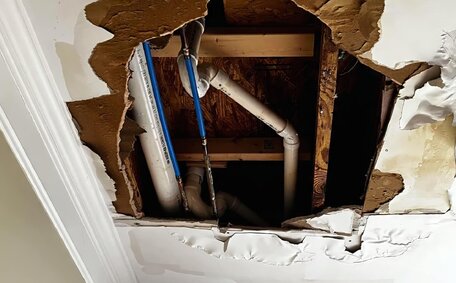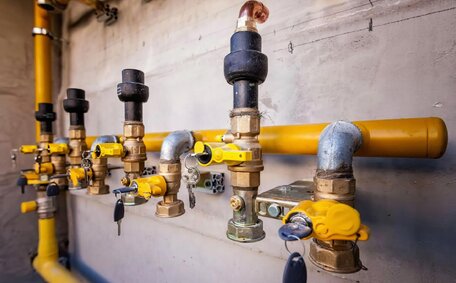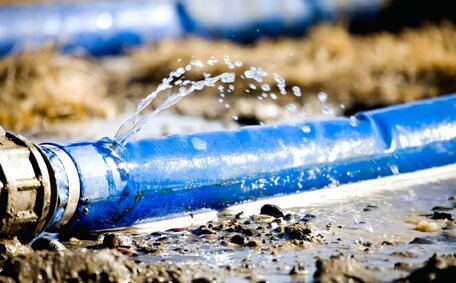What Is Pipe Patching?
Pipe patching quickly addresses small, specific areas of damage by sealing cracks or holes with a patch, avoiding the need to replace entire sections of pipe.
While patching is an affordable short-term solution for minor pipe damage, it’s less durable than comprehensive relining or replacement.
The pipe patching process typically involves:
- Identifying and accessing the damaged section of pipe
- Cleaning and preparing the pipe surface
- Cutting away any protruding sections or rough edges
- Applying an epoxy, sealant or patch material over the damaged area
- Securing the patch in place and allowing ample time for it to cure
Pipe patching is best suited for minor damages that are isolated and under 75 mm in size. It’s particularly effective for treatments like pinhole leaks, minimal cracks, separated pipe joints and localised rust. For larger damages, however, a patch might fail to stick effectively or offer a durable repair.
Although patching is a wallet-friendly option for fixing a blocked drain and avoids major excavation, it might require multiple repairs eventually. Patching doesn’t rectify more complex issues like pipe misalignment, pervasive rust, tree root infiltration, or extensive pipe failure likely to recur.
Defining The Pipe Patching Process
The pipe patching process involves a few key steps to repair damaged sections of pipework:
- Locating the Damaged Area - The first step is to identify and access the precise location of the cracked, corroded or leaking section of the damaged pipe. This may require some exploratory excavation.
- Surface Preparation - The pipe surface should be meticulously cleaned, air-dried and textured to enhance the adhesion of the patch material.
- Edge Repair - Any loose debris, sharp edges or protruding sections around the damaged area are cut back to create a clean boundary.
- Applying the Patch - An appropriate patch material is selected, mixed/activated, and used to cover the damaged surface. This may involve fibre-reinforced epoxies, mechanical clamp patches or custom welded metal plates for area pipe repair.
- Curing and Sealing - The pipe patch is left to fully cure and seal according to specifications, often needing 24 hours or more to reach maximum strength.
This technique is applicable to different materials, including concrete, clay, steel, and PVC pipes. It works best for holes and cracks less than 75mm wide on pipes in otherwise good condition. If surrounding pipe corrosion is severe, replacements or relining may be better options.
What Is Pipe Relining?
Pipe relining is a no-dig method for repairing old, damaged, or burst pipes by inserting a new lining inside the existing pipe structure. This creates a 'pipe within a pipe’ without having to dig up and replace your pipes.
The pipe relining process involves:
- Inspecting your drain pipe internally using a camera to locate damage
- Cleaning and preparing the inside of the pipes
- Blowing a resin-saturated liner tube inside the pipe, expanding it to fit snugly against the pipe walls
- Curing the liner using hot water, steam or UV light so it hardens
Pipe relining adequately addresses various issues, from cracks and leaks to root ingress and decay, which might typically necessitate pipe replacement. By reinforcing the inside walls, it can restore structural stability to broken pipes and prevent further leaks, while avoiding major property disruption.
A relined pipe can generally function optimally for over 50 years. As opposed to patching, relining offers an enduring resolution for the entire pipe network.
Understanding The Pipe Relining Process
The pipe relining process is a multi-step trenchless method to reinforce damaged pipes without having to dig them up.
- Inspection - A camera is fed through the pipes to locate cracks, leaks and other issues. This identifies damaged sections needing repair.
- Cleaning & Prep - The interior pipes are scrubbed and cleared of any debris, grease or mineral deposits to prepare the surface.
- Relining - A resin-saturated liner or sleeve is blown or pulled into the host pipe, expanding to fit snugly against the walls.
- Curing - The liner is cured, either by circulating hot water to heat-activate the resin, or by using steam or UV light. This causes it to harden into a tough, durable pipe lining.
Pipe relining capitalises on the existing pipe framework, hence avoiding the need for trench digging or landscape alterations. The resin liner adheres to the inner pipe walls, sealing fissures and reinforcing vulnerable areas to avert additional harm. Contrasted with the targeted approach of patching, relining ensures extensive structural rejuvenation along the full pipe length.
Pipe relining effectively tackles root incursions, breaks, collapses, and corrosion in sewer pipes. It’s quicker and less disruptive than complete pipe replacement. For repairs that stand the test of time, sewer pipe relining is frequently the preferred choice.
Comparing The Scope: Localized Repairs vs Whole-Pipe Renovations
When it comes to pipe repairs, understanding the scope and scale of damage is key in determining whether localised patching or whole-pipe relining is most suitable.
Pipe patching entails applying epoxy, sealant, or a clamp to localised damage under 75mm in width. It serves as an immediate, affordable fix for minor issues like pinholes, small cracks and joint leaks.
Conversely, relining is the comprehensive alternative for addressing extensive pipe damage. Relining revitalises old pipes from the inside, offering integral reinforcement along their full length. The robust, resin-based liner provides over 50 years of strength, sealing cracks and reinforcing fragile zones.
Here’s an overview of their differences in scope and applications:
- Pipe Patching
- Localised repairs for minor, isolated damage under 75mm
- Cost-effective for temporary fixes
- May need repeated repairs over time
- Doesn’t address widespread pipe failure issues
- Pipe Relining
- Whole-pipe reinforcement; repairs entire length
- Long-term solution, with 50+ year lifespan
- Fixes cracks, leaks, holes, root intrusion
- Good for widespread/severe damage
When plumbing issues arise, the damage extent guides whether simple patching or full-scale relining is best. For small leaks or cracks, patches offer a handy fix, and this is why we evaluate each situation carefully. But for reinforced pipes built to last, relining is the go-to renovation choice.
Evaluating Longevity: Short-Term Patches vs Lasting Structural Repairs
When it comes to longevity and durability of repairs, pipe relining far outlasts basic patching. According to industry standards, the average life expectancy of a relined pipe is 50 years or more before needing renewal. This extensive lifespan contrasts patching small areas, which serve as short-term solutions needing repeated fixes every few years.
Installing a durable, resin-based liner throughout the pipe’s interior provides structural reinforcement and ensures lasting pipe condition for years to come. The durable liner is highly resistant to factors causing typical pipe damage like cracks, chemical corrosion and intruding tree roots.
While pipe patching can temporarily seal off pinhole leaks and small holes at a lower cost, these narrow repairs do little to address widespread weakness and deterioration issues. Past the patched area, severely corroded pipes remain vulnerable to failing again which can lead to costly, recurring repairs.
In the long run, undergoing whole-pipe relining is an investment in lasting plumbing infrastructure built to endure years of use with much lower maintenance. Homeowners looking for permanent pipe repairs rather than temporary fixes should consider the superior option of pipe relining.
Analyzing Costs: Immediate Savings vs Long-Term Investments
When weighing financial decisions regarding pipe repairs, there is often a trade-off between immediate cost savings from quick fixes versus long-term investments in comprehensive solutions. Understanding these cost factors helps guide appropriate choices.
Patches provide temporary relief on the cheap by sealing small damaged areas at around $150-300 per repair. But repeatedly patching leaks every few years racks up expenses. And if more pipes fail, restoration costs pile up to fix resultant flooding or foundation damage.
In contrast, whole pipe relining cost typically ranges from $2000-4000 but delivers lasting infrastructure, averting major restoration fees. By renewing old pipes for 50+ years rather than just patching them, ensure they work out more economical in the bigger picture through:
- Preventing recurrent repairs (saving $1000s over decades)
- Reducing risk of property damage from leaks
- Minimising landscaping displacement from repeat dig-ups
While individuals often opt for affordable patch jobs, from a long-range perspective, investment in full-scale reinforced plumbing tends to pay itself back in durability and damage prevention down the track.
So for sustainable pipes built to last, proactive relining makes financial sense. Guard against escalating costs of frequent patching by investing upfront in durable pipe integrity with professional relining services.
Assessing Disruption: Trenchless vs Traditional Replacement
When it comes to pipe repair methods, traditional replacement that requires digging trenches can cause major disruption compared to trenchless pipe relining.
With traditional pipe replacement, yards need to be excavated to access and remove damaged pipes. This can involve jackhammering, extensive digging and trenching, and the displacement of landscaping features like gardens, trees or driveways. It also often requires closing off water or sewer lines for long periods, inconveniencing households.
In contrast, pipe relining is a trenchless method that renews your plumbing from the inside out with minimal ground displacement. After an initial inspection, a tough resin liner is blown or pulled into the pipes’ interior and expanded to seal cracks and reinforce weak spots.
As external pipe access isn’t required, relining avoids digging and keeps gardens intact.
Key benefits of this trenchless approach include:
- No excavation preserving gardens/landscaping
- Faster repairs without digging trenches
- Less property disruption and dust
- Shorter downtime of plumbing systems
So when evaluating pipe repair options, pipe relining delivers underground pipe renovations without the mess and upheaval of traditional dig-ups. Revitalise aging pipes with seamless relining that keeps your property unscathed.
When To Choose Patching vs Relining
Deciding on pipe relining vs replacement depends on assessing the damage and determining the best long-term solution.
Patches are a speedy, budget-friendly solution for minor cracks or leaks under 75 mm. But for extensive pipe damage beyond a few small areas, comprehensive relining is the wiser investment for robust and lasting repairs.
Consider key factors like:
- Damage extent - Localised issues suit patching; widespread problems warrant relining
- Urgency of repair - Patches offer prompt solutions to immediate issues
- Durability – Patches serve as a brief fix, while relining ensures over 50 years of pipe fortification
- Yard impact - Full pipe replacements require digging; relining is a tidy, trenchless method
- Future issues - Patches address symptoms but risk reoccurring damage if underlying problems persist
In the end, consulting an expert like Lindfield Plumbing is advisable to accurately assess damage and objectively gauge whether patches or full-scale relining will provide the most sensible and sustainable solution.
Patches grant quick fixes for minor, solitary pipe issues; yet for professional advice and durable solutions, reach out to Lindfield Plumbing. On the other hand, for thorough reinforcement to prevent future leakage, opting for pipe relining is the superior, long-lasting solution. Contact Lindfield Plumbing to get job done efficiently with an on-site assessment and discuss repair options suited for your needs.






